The Effect of Route Choice in Children’s Exposure to Ultrafine Particles Whilst Walking to School
Abstract
:1. Introduction
2. Materials and Methods
2.1. Data Collection
2.2. Instrumentation
2.3. Meteorology
2.4. Data Analysis
3. Results
3.1. Background UFP
3.2. Variations in Exposure to UFP between Routes
3.3. Elevated Exposure
4. Discussion
5. Conclusions
Supplementary Materials
Author Contributions
Funding
Institutional Review Board Statement
Informed Consent Statement
Data Availability Statement
Acknowledgments
Conflicts of Interest
References
- Collins, D.C.; Kearns, R.A. Geographies of inequality: Child pedestrian injury and walking school buses in Auckland, New Zealand. Soc. Sci. Med. 2005, 60, 61–69. [Google Scholar] [CrossRef]
- Larouche, R.; Mendoza, J.A. 15–Walking School Buses and Bicycle Trains, in Children’s Active Transportation; Larouche, R., Ed.; Elsevier: Amsterdam, The Netherlands, 2018; pp. 217–228. [Google Scholar]
- Mendoza, J.A.; Watson, K.; Chen, T.A.; Baranowski, T.; Nicklas, T.A.; Uscanga, D.K.; Hanfling, M.J. Impact of a pilot walking school bus intervention on children’s pedestrian safety behaviors: A pilot study. Health Place 2012, 18, 24–30. [Google Scholar] [CrossRef] [Green Version]
- Kearns, R.A.; Collins, D.C.A.; Neuwelt, P.M. The walking school bus: Extending children’s geographies? Area 2003, 35, 285–292. [Google Scholar] [CrossRef]
- Rivas, I.; Donaire-Gonzalez, D.; Bouso, L.; Esnaola, M.; Pandolfi, M.; De Castro, M.; Viana, M.; Pedrerol, M.Á.; Nieuwenhuijsen, M.; Alastuey, A.; et al. Spatiotemporally resolved black carbon concentration, schoolchildren’s exposure and dose in Barcelona. Indoor Air 2016, 26, 391–402. [Google Scholar] [CrossRef] [PubMed] [Green Version]
- Garcia-Algar, O.; Canchucaja, L.; D’Orazzio, V.; Manich, A.; Joya, X.; Vall, O. Different exposure of infants and adults to ultrafine particles in the urban area of Barcelona. Environ. Monit. Assess. 2014, 187, 4196. [Google Scholar] [CrossRef]
- Ntarladima, A.M.; Vaartjes, I.; Grobbee, D.E.; Dijst, M.; Schmitz, O.; Uiterwaal, C.; Dalmeijer, G.; Van Der Ent, C.; Hoek, G.; Karssenberg, D. Relations between air pollution and vascular development in 5-year old children: A cross-sectional study in the Netherlands. Environ. Health 2019, 18, 50. [Google Scholar] [CrossRef] [Green Version]
- García-Hernández, C.; Ferrero, A.; Estarlich, M.; Ballester, F. Exposure to ultrafine particles in children until 18 years of age: A systematic review. Indoor Air 2020, 30, 7–23. [Google Scholar] [CrossRef]
- Heinzerling, A.; Hsu, J.; Yip, F. Respiratory Health Effects of Ultrafine Particles in Children: A Literature Review. Water Air Soil Pollut. 2016, 227, 32. [Google Scholar] [CrossRef] [PubMed] [Green Version]
- Da Costa e Oliveira, J.R.; Base, L.H.; de Abreu, L.C.; Filho, C.F.; Ferreira, C.; Morawska, L. Ultrafine particles and children’s health: Literature review. Paediatr. Respir. Rev. 2019, 32, 73–81. [Google Scholar] [CrossRef] [PubMed]
- HEI. Review Panel on Ultrafine Particles, Understanding the Health Effects of Ambient Ultrafine Particles; HEI Perspectives Health Effects Institute: Boston, MA, USA, 2013. [Google Scholar]
- Rafiepourgatabi, M.; Woodward, A.; Salmond, J.A.; Dirks, K.N. The Impact of Route Choice on Active Commuters’ Exposure to Air Pollution: A Systematic Review. Front. Sustain. Cities 2021, 2. [Google Scholar] [CrossRef]
- Fatma, A.-W.; Ahmed, A.-A.; Nathan, K.; Michelle, Z.; Al-Widyan, F.; Al-Ani, A.; Kirchner, N.; Zeibots, M. An effort-based evaluation of pedestrian route choice. Sci. Res. Essays 2017, 12, 42–50. [Google Scholar] [CrossRef] [Green Version]
- Hewawasam, C.; Bandara, S.; Wirasinghe, S. Analysis of factors affecting pedestrian route choice. J. Chem. Inf. Model 2013, 53, 1689–1699. [Google Scholar]
- Ahmed, S.; Adnan, M.; Janssens, D.; Wets, G. A route to school informational intervention for air pollution exposure reduction. Sustain. Cities Soc. 2020, 53. [Google Scholar] [CrossRef]
- Broach, J.; Bigazzi, A.Y. Existence and Use of Low-Pollution Route Options for Observed Bicycling Trips. Transp. Res. Rec. 2017, 2662, 152–159. [Google Scholar] [CrossRef]
- Molter, A.; Lindley, S. Influence of walking route choice on primary school children’s exposure to air pollution—A proof of concept study using simulation. Sci. Total Environ. 2015, 530–531, 257–262. [Google Scholar] [CrossRef]
- Ma, X.; Longley, I.; Gao, J.; Salmond, J. Evaluating the Effect of Ambient Concentrations, Route Choices, and Environmental (in)Justice on Students’ Dose of Ambient NO2 While Walking to School at Population Scales. Environ. Sci. Technol. 2020, 54, 12908–12919. [Google Scholar] [CrossRef]
- Dias, D.; Tchepel, O. Spatial and Temporal Dynamics in Air Pollution Exposure Assessment. Int. J. Environ. Res. Public Health 2018, 15, 558. [Google Scholar] [CrossRef] [Green Version]
- McCreanor, J.; Cullinan, P.; Nieuwenhuijsen, M.J.; Stewart-Evans, J.; Malliarou, E.; Jarup, L.; Harrington, R.; Svartengren, M.; Han, I.-K.; Ohman-Strickland, P.; et al. Respiratory Effects of Exposure to Diesel Traffic in Persons with Asthma. N. Engl. J. Med. 2007, 357, 2348–2358. [Google Scholar] [CrossRef] [Green Version]
- Rafiepourgatabi, M.; Woodward, A.; Salmond, J.; Dirks, K. Socioeconomic Status and Route Characteristics in Relation to Children’s Exposure to Air Pollution from Road Traffic While Walking to School in Auckland, New Zealand. Int. J. Environ. Res. Public Health 2021, 18, 4996. [Google Scholar] [CrossRef] [PubMed]
- Brand, V.S.; Kumar, P.; Damascena, A.S.; Pritchard, J.P.; Geurs, K.T.; Andrade, M.D.F. Impact of route choice and period of the day on cyclists’ exposure to black carbon in London, Rotterdam and São Paulo. J. Transp. Geogr. 2019, 76, 153–165. [Google Scholar] [CrossRef]
- Dirks, K.N.; Salmond, J.A.; Talbot, N. Air Pollution Exposure in Walking School Bus Routes: A New Zealand Case Study. Int. J. Environ. Res. Public Health 2018, 15, 2802. [Google Scholar] [CrossRef] [PubMed] [Green Version]
- Dirks, K.N.; Wang, J.Y.T.; Khan, A.; Rushton, C. Air Pollution Exposure in Relation to the Commute to School: A Bradford UK Case Study. Int. J. Environ. Res. Public Health 2016, 13, 1064. [Google Scholar] [CrossRef] [PubMed] [Green Version]
- Good, N.; Mölter, A.; Ackerson, C.; Bachand, A.; Carpenter, T.; Clark, M.; Fedak, K.M.; Kayne, A.; Koehler, K.; Moore, B.; et al. The Fort Collins Commuter Study: Impact of route type and transport mode on personal exposure to multiple air pollutants. J. Expo. Sci. Environ. Epidemiol. 2016, 26, 397–404. [Google Scholar] [CrossRef]
- Hofman, J.; Samson, R.; Joosen, S.; Blust, R.; Lenaerts, S. Cyclist exposure to black carbon, ultrafine particles and heavy metals: An experimental study along two commuting routes near Antwerp, Belgium. Environ. Res. 2018, 164, 530–538. [Google Scholar] [CrossRef] [PubMed]
- Jarjour, S.; Jerrett, M.; Westerdahl, D.; De Nazelle, A.; Hanning, C.; Daly, L.; Lipsitt, J.; Balmes, J. Cyclist route choice, traffic-related air pollution, and lung function: A scripted exposure study. Environ. Health 2013, 12, 14. [Google Scholar] [CrossRef] [PubMed] [Green Version]
- Jereb, B.; Batkovič, T.; Herman, L.; Šipek, G.; Kovše, Š.; Gregorič, A.; Močnik, G. Exposure to Black Carbon during Bicycle Commuting–Alternative Route Selection. Atmosphere 2018, 9, 21. [Google Scholar] [CrossRef] [Green Version]
- Luengo-Oroz, J.; Reis, S. Assessment of cyclists’ exposure to ultrafine particles along alternative commuting routes in Edinburgh. Atmos. Pollut. Res. 2019, 10, 1148–1158. [Google Scholar] [CrossRef]
- Pattinson, W.; Kingham, S.; Longley, I.; Salmond, J. Potential pollution exposure reductions from small-distance bicycle lane separations. J. Transp. Health 2017, 4, 40–52. [Google Scholar] [CrossRef]
- Strak, M.; Boogaard, H.; Meliefste, K.; Oldenwening, M.; Zuurbier, M.; Brunekreef, B.; Hoek, G. Respiratory health effects of ultrafine and fine particle exposure in cyclists. Occup. Environ. Med. 2010, 67, 118–124. [Google Scholar] [CrossRef] [Green Version]
- Stats, N.Z. 2018 Census Population and Dwelling Counts. 2020. Available online: www.stats.govt.nz/information-releases/2018-census-population-and-dwelling-counts (accessed on 23 January 2021).
- Symons, J.K.; Leksmono, N.S.; Hayes, E.T.; Chatterton, T.J.; Longhurst, J.W.S. Air quality management in Auckland, New Zealand. Air Pollut. XV 2007, 1, 169–179. [Google Scholar] [CrossRef]
- Dirks, K.N.; Kirkland, T.; Wang, J.Y.T.; Salmond, J.A. The Consequences of Vehicle Emission Legislation on Pedestrian Exposure in the Journey to School: A Comparison of the United Kingdom and New Zealand. In Proceedings of the ISEE 2017, Sydney, Australia, 23 March 2017. [Google Scholar]
- Brugge, D.; Patton, A.P.; Bob, A.; Reisner, E.; Lowe, L.; Bright, O.-J.M.; Durant, J.L.; Newman, J.; Zamore, W. Developing Community-Level Policy and Practice to Reduce Traffic-Related Air Pollution Exposure. Environ. Justice 2015, 8, 95–104. [Google Scholar] [CrossRef] [Green Version]
- Buzzard, N.A.; Clark, N.N.; Guffey, S.E. Investigation into pedestrian exposure to near-vehicle exhaust emissions. Environ. Health 2009, 8, 13. [Google Scholar] [CrossRef] [Green Version]
- TSI, P-Trak Ultrafine Particle Counter Model 8525. 2013. Available online: https://tsi.com/products/indoor-air-quality-meters-instruments/indoor-air-quality-meters/p-trak-ultrafine-particle-counter-8525/ (accessed on 20 January 2021).
- Qstarz International Co., L. BT-Q1000x Travel Recorder. Available online: http://www.qstarz.com/Products/GPS%20Products/BT-Q1000X-S.htm (accessed on 29 December 2018).
- Samsung. Galaxy S8+. Available online: www.samsung.com/ca/smartphones/galaxy-s8/camera/ (accessed on 18 February 2021).
- Samsung. Galaxy Note10 Lite. 2021. Available online: www.samsung.com/in/smartphones/galaxy-note10-lite/ (accessed on 18 February 2021).
- NIWA. The National Climate Database. 2019. Available online: https://cliflo.niwa.co.nz/pls/niwp/wgenf.genform1 (accessed on 25 December 2019).
- Service UNW. Beaufort Wind Scale. 2021. Available online: www.weather.gov/mfl/beaufort (accessed on 24 May 2021).
- Group U.S.C. Introduction to Generalized Linear Mixed Models. 2021. Available online: https://stats.idre.ucla.edu/other/mult-pkg/introduction-to-generalized-linear-mixed-models/ (accessed on 6 July 2021).
- Esri. ArcGIS; Version: 10.7.1.; Esri: Redlands, CA, USA, 2020. [Google Scholar]
- MATLAB: 9.9.0.1570001 (R2020b) Update 4. 2020; The MathWorks Inc.: Natick, MA, USA, 2020.
- Team, R. Integrated Development Environment for R; RStudio PBC: Boston, MA, USA, 2021. [Google Scholar]
- Dons, E.; Laeremans, M.; Orjuela, J.P.; Avila-Palencia, I.; de Nazelle, A.; Nieuwenhuijsen, M.; Van Poppel, M.; Carrasco-Turigas, G.; Standaert, A.; De Boever, P.; et al. Transport most likely to cause air pollution peak exposures in everyday life: Evidence from over 2000 days of personal monitoring. Atmos. Environ. 2019, 213, 424–432. [Google Scholar] [CrossRef]
- Tan, S.H.; Roth, M.; Velasco, E. Particle exposure and inhaled dose during commuting in Singapore. Atmos. Environ. 2017, 170, 245–258. [Google Scholar] [CrossRef]
- Qiu, Z.; Wang, W.; Zheng, J.; Lv, H. Exposure assessment of cyclists to UFP and PM on urban routes in Xi’an, China. Environ. Pollut. 2019, 250, 241–250. [Google Scholar] [CrossRef] [PubMed]
- Kumar, P.; Rivas, I.; Sachdeva, L. Exposure of in-pram babies to airborne particles during morning drop-in and afternoon pick-up of school children. Environ. Pollut. 2017, 224, 407–420. [Google Scholar] [CrossRef] [PubMed]
- Shammut, M.; Cao, M.; Zhang, Y.; Papaix, C.; Liu, Y.; Gao, X. Banning Diesel Vehicles in London: Is 2040 Too Late? Energies 2019, 12, 3495. [Google Scholar] [CrossRef] [Green Version]
- Sudiana, K.; Sule, E.T.; Soemaryani, I.; Yunizar, Y. The Development and Validation of the Penta Helix Construct. Bus. Theory Pract. 2020, 21, 136–145. [Google Scholar] [CrossRef] [Green Version]
- Lim, S.S.; Allen, K.; Bhutta, Z.A.; Dandona, L.; Forouzanfar, M.H.; Fullman, N.; Gething, P.W.; Goldberg, E.M.; Hay, S.I.; Holmberg, M.; et al. Measuring the health-related Sustainable Development Goals in 188 countries: A baseline analysis from the Global Burden of Disease Study 2015. Lancet 2016, 388, 1813–1850. [Google Scholar] [CrossRef] [Green Version]
- Caraka, R.; Noh, M.; Chen, R.-C.; Lee, Y.; Gio, P.; Pardamean, B. Connecting Climate and Communicable Disease to Penta Helix Using Hierarchical Likelihood Structural Equation Modelling. Symmetry 2021, 13, 657. [Google Scholar] [CrossRef]
- Schultz, E.S.; Litonjua, A.A.; Melén, E. Effects of Long-Term Exposure to Traffic-Related Air Pollution on Lung Function in Children. Curr. Allergy Asthma Rep. 2017, 17, 1–13. [Google Scholar] [CrossRef] [PubMed] [Green Version]

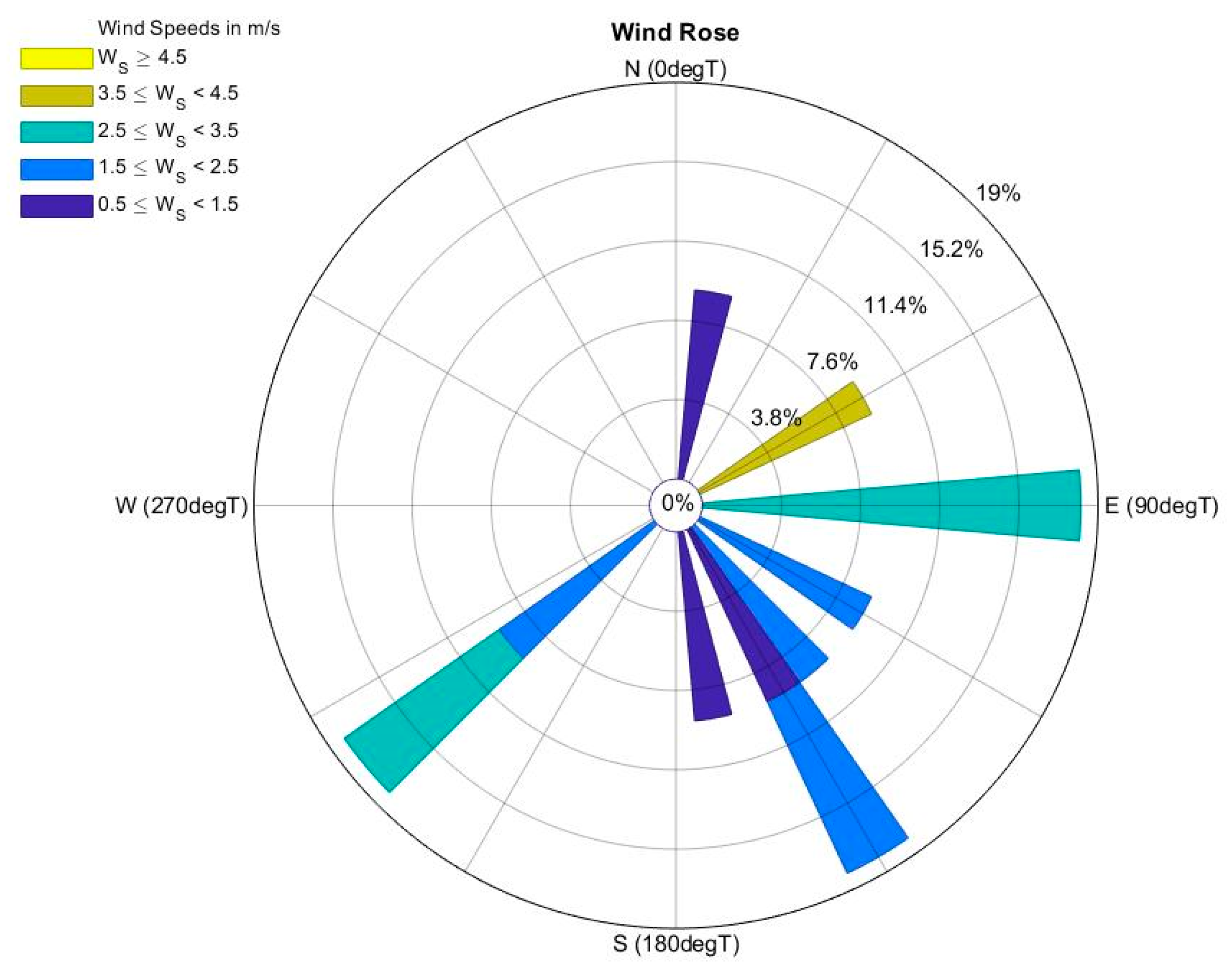
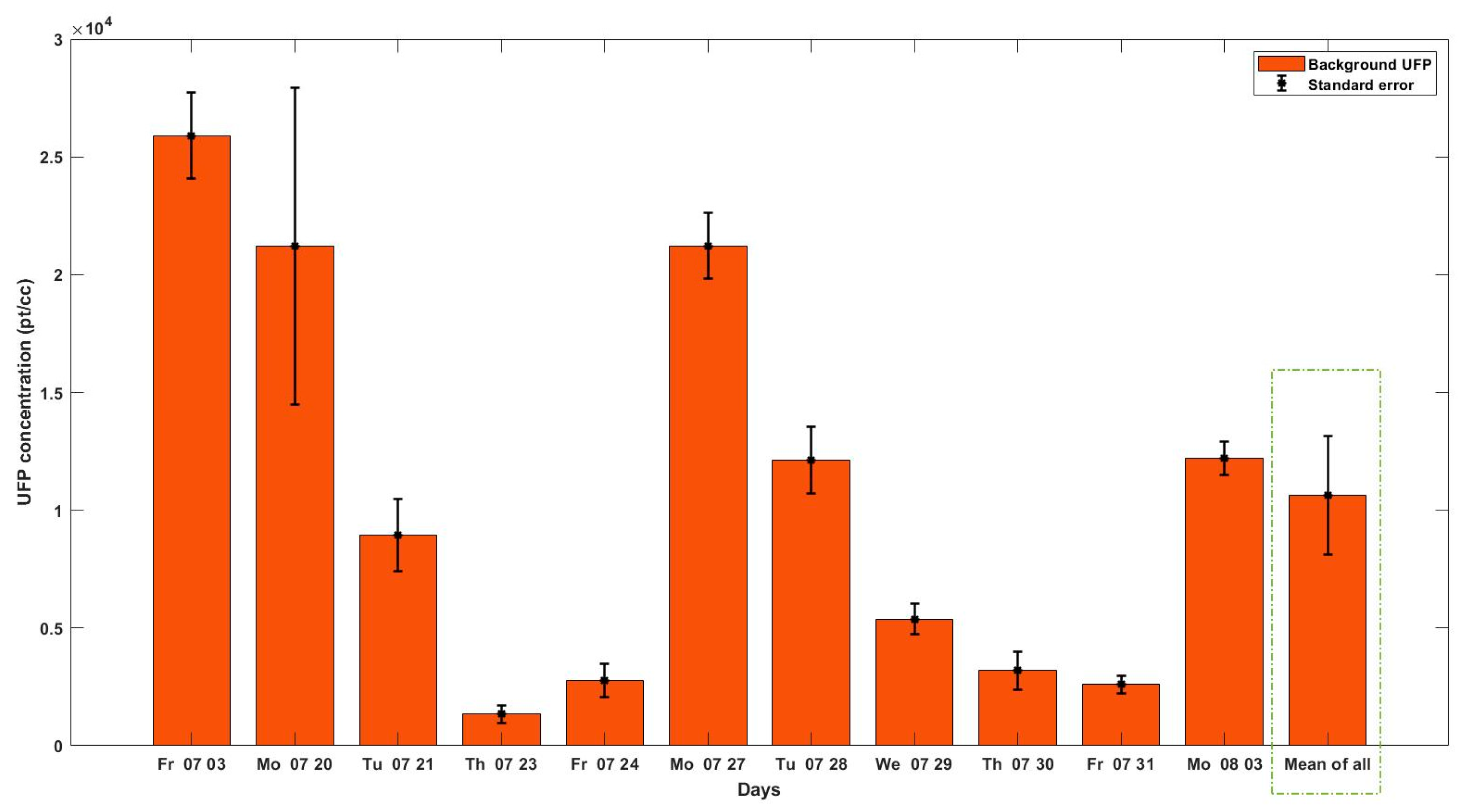

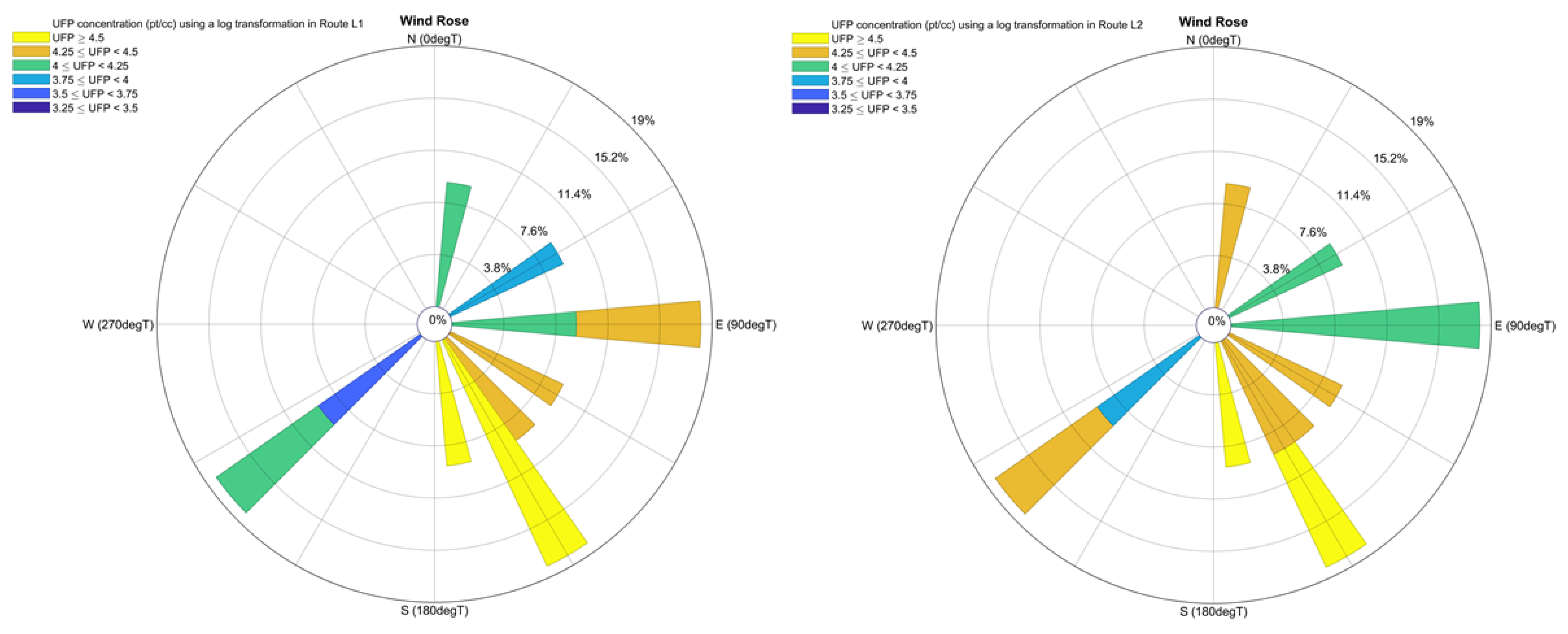
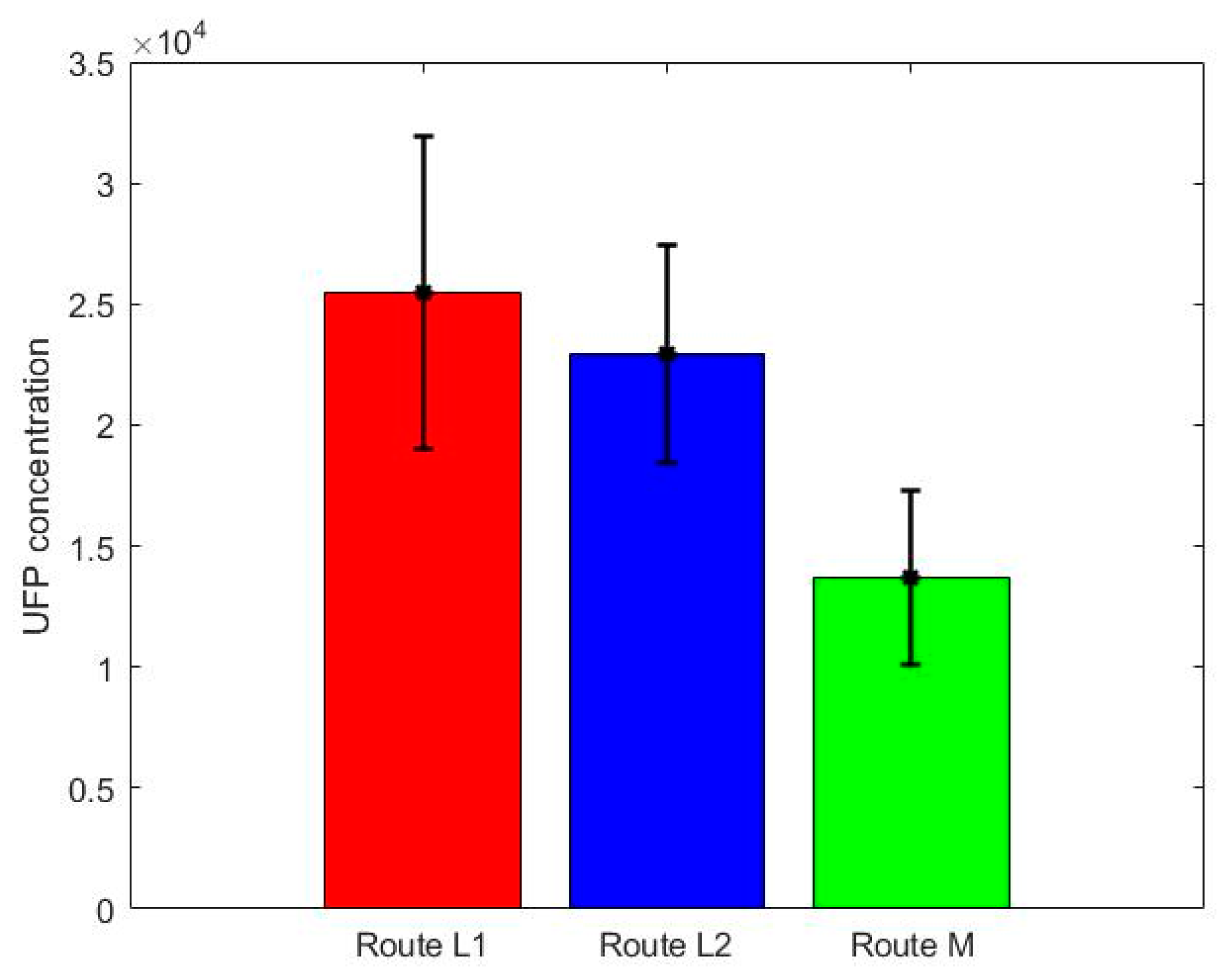
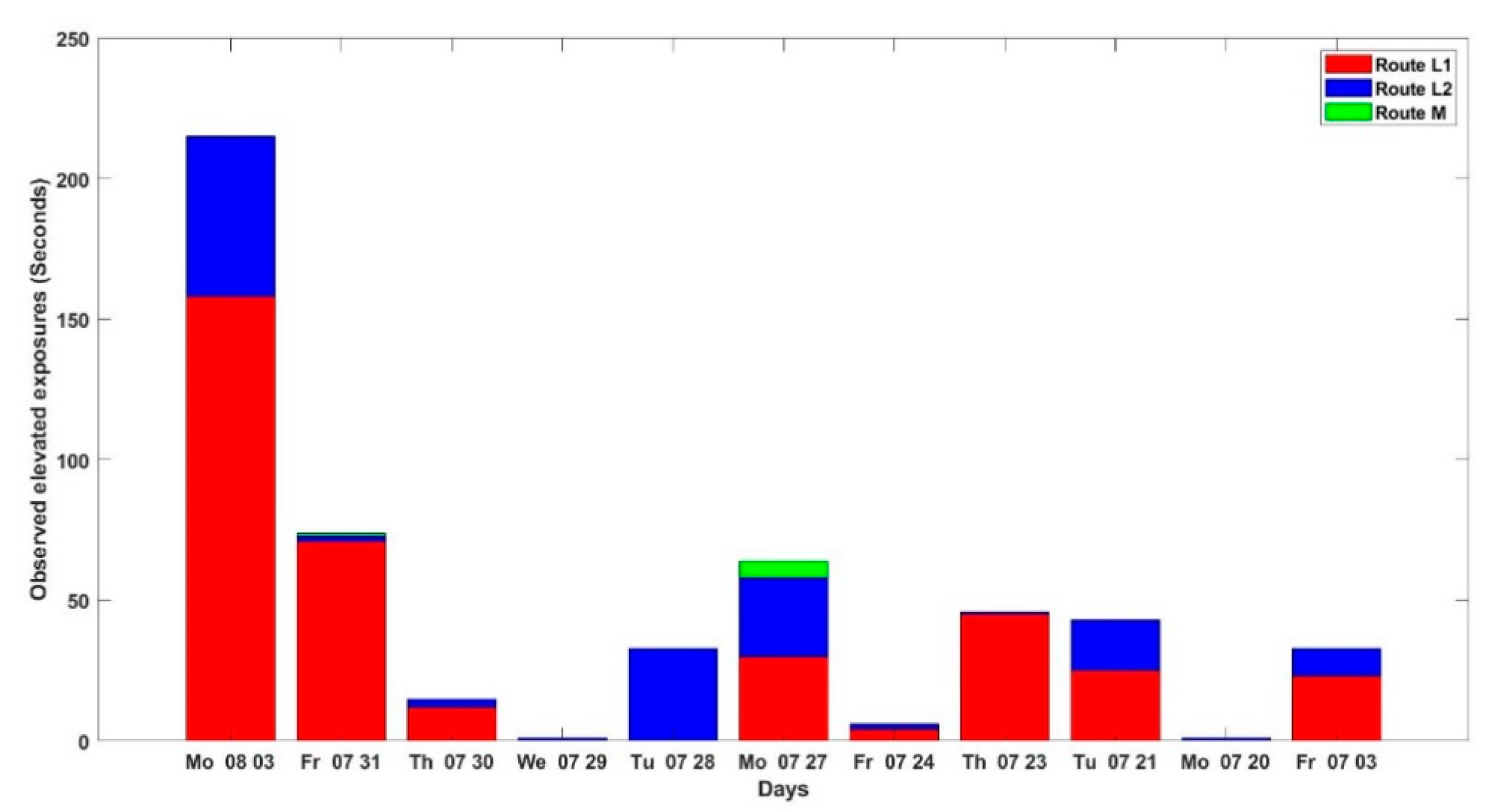

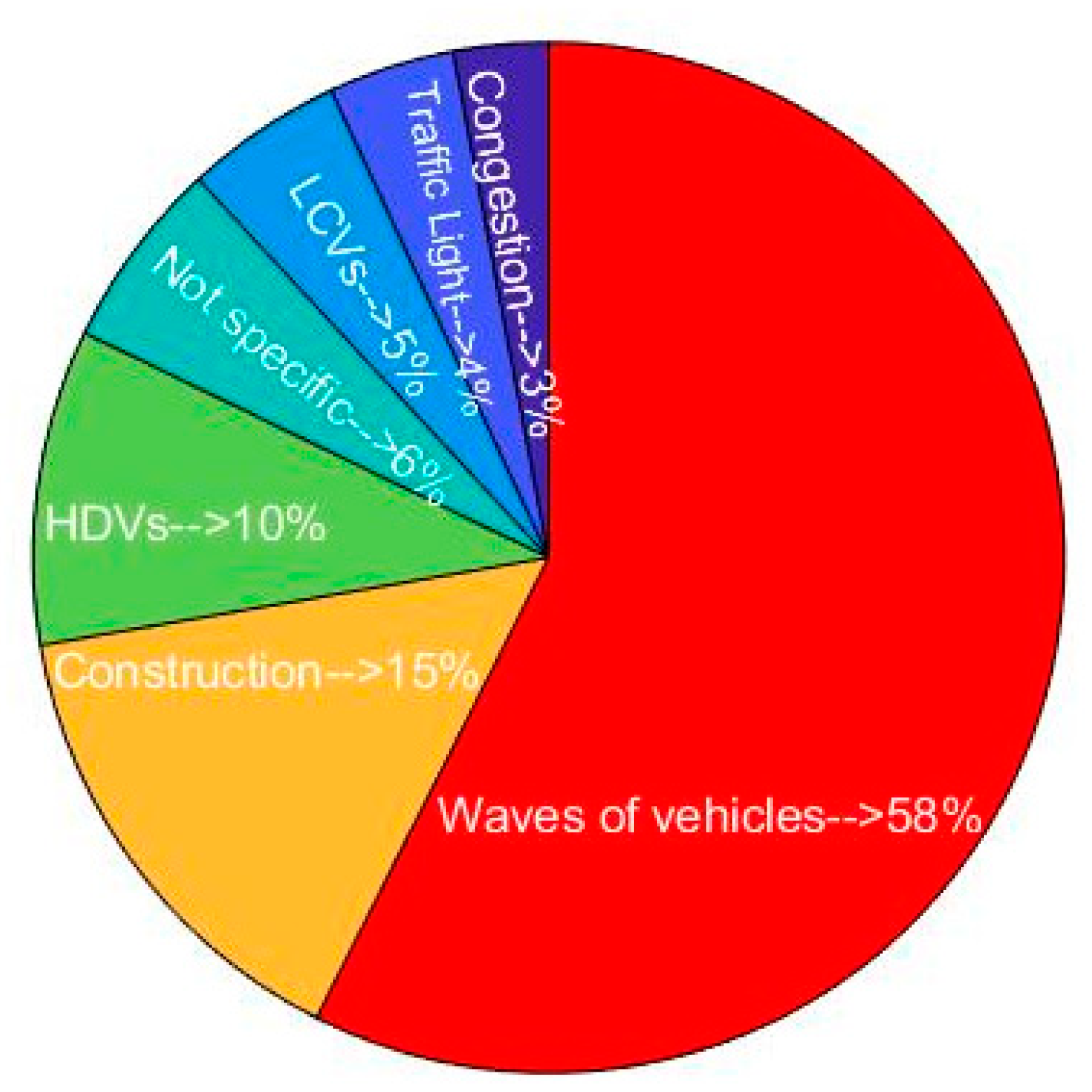
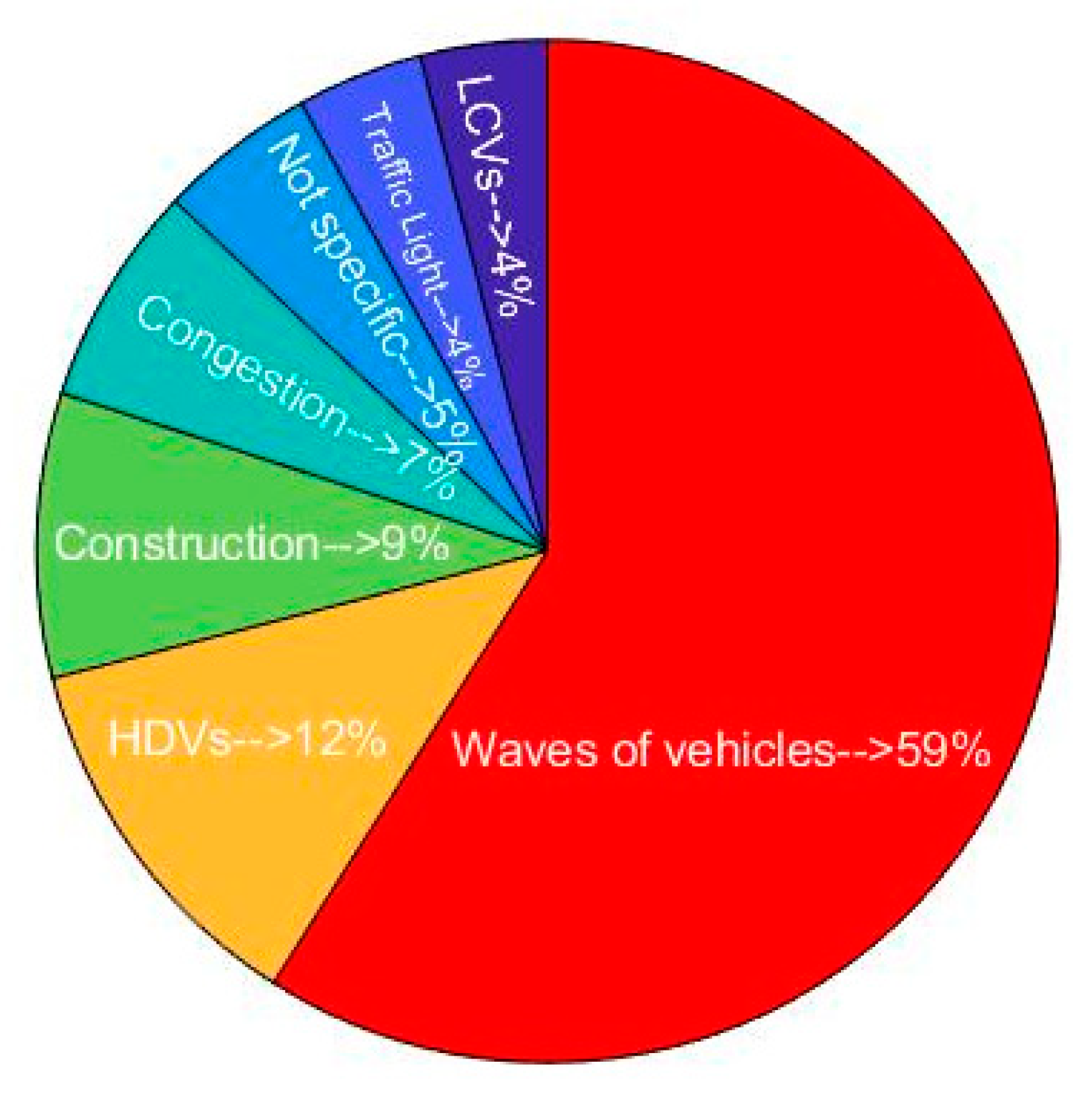
| Mean Traffic on the Left Side (#veh/min) | Mean Traffic on the Right Side (#veh/min) | Mean HDV’s Flow on the Right Side (#veh/min) | Mean HDV Flow on the Right Side (#veh/min) |
|---|---|---|---|
| 5.73 ± 1.01 | 16.96 ± 1.97 | 0.43 ± 0.22 | 0.91 ± 0.43 |
| Wind Direction (Mean ± Std) (Deg) | Wind Speed (Mean ± Std) (m/s) | Temperature (Mean ± Std) (°C) | Relative Humidity (Mean ± Std) (%) | |
|---|---|---|---|---|
| 20200703 (D1) | 145.33 ± 5.77 | 0.60 ± 0.36 | 1.80 ± 0.46 | 100.00 ± 0.00 |
| 20200720 (D2) | 154.67 ± 5.03 | 2.03 ± 0.15 | 10.70 ± 0.62 | 94.33 ± 2.52 |
| 20200721 (D3) | 13.67 ± 4.62 | 1.00 ± 0.10 | 12.50 ± 0.36 | 99.33 ± 1.15 |
| 20200723 (D4) | 230.75 ± 7.18 | 2.70 ± 1.16 | 12.33 ± 0.53 | 85.50 ± 2.38 |
| 20200724 (D5) | 228.00 ± 14.73 | 2.03 ± 0.93 | 11.87 ± 0.25 | 90.67 ± 0.58 |
| 20200727 (D6) | 171.67 ± 17.62 | 1.17 ± 0.45 | 5.77 ± 0.60 | 100.00 ± 0.00 |
| 20200728 (D7) | 123.00 ± 6.98 | 1.98 ± 0.17 | 11.95 ± 0.39 | 86.50 ± 1.29 |
| 20200729 (D8) | 94.50 ± 5.51 | 2.58 ± 0.24 | 11.85 ± 0.26 | 79.25 ± 1.71 |
| 20200730 (D9) | 87.25 ± 3.86 | 2.78 ± 0.26 | 12.60 ± 0.29 | 71.00 ± 2.16 |
| 20200731 (D10) | 60.25 ± 4.35 | 4.33 ± 0.63 | 13.50 ± 0.18 | 71.50 ± 1.29 |
| 20200803 (D11) | 138.33 ± 5.69 | 2.40 ± 0.26 | 10.53 ± 0.38 | 94.00 ± 2.00 |
| Route | Estimate | Lower | Upper | t-Stat | p-Value |
|---|---|---|---|---|---|
| L1 | 4.290 | 4.078 | 4.502 | 41.18 | |
| L2 | 4.288 | 4.076 | 4.500 | 41.16 | |
| M | 3.967 | 3.755 | 4.179 | 38.08 |
| Routes | Estimate | Lower | Upper | z-Value | p-Value |
|---|---|---|---|---|---|
| L1 | 2.716 | 1.802 | 3.631 | 5.836 | |
| L2 | 1.858 | 0.936 | 2.780 | 3.959 | |
| M | −1.246 | −2.417 | −0.075 | −2.089 | 0.0367 |
Publisher’s Note: MDPI stays neutral with regard to jurisdictional claims in published maps and institutional affiliations. |
© 2021 by the authors. Licensee MDPI, Basel, Switzerland. This article is an open access article distributed under the terms and conditions of the Creative Commons Attribution (CC BY) license (https://creativecommons.org/licenses/by/4.0/).
Share and Cite
Rafiepourgatabi, M.; Woodward, A.; Salmond, J.A.; Dirks, K.N. The Effect of Route Choice in Children’s Exposure to Ultrafine Particles Whilst Walking to School. Int. J. Environ. Res. Public Health 2021, 18, 7808. https://doi.org/10.3390/ijerph18157808
Rafiepourgatabi M, Woodward A, Salmond JA, Dirks KN. The Effect of Route Choice in Children’s Exposure to Ultrafine Particles Whilst Walking to School. International Journal of Environmental Research and Public Health. 2021; 18(15):7808. https://doi.org/10.3390/ijerph18157808
Chicago/Turabian StyleRafiepourgatabi, Mehrdad, Alistair Woodward, Jennifer A. Salmond, and Kim Natasha Dirks. 2021. "The Effect of Route Choice in Children’s Exposure to Ultrafine Particles Whilst Walking to School" International Journal of Environmental Research and Public Health 18, no. 15: 7808. https://doi.org/10.3390/ijerph18157808







